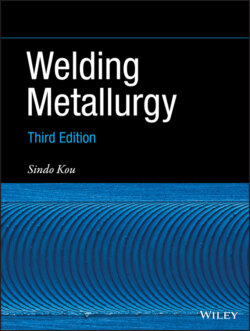Читать книгу Welding Metallurgy - Sindo Kou - Страница 36
1.3.4.2 Shielding Gases
ОглавлениеArgon, helium, and their mixtures are used for nonferrous metals as well as stainless and alloy steels. The arc energy is less uniformly dispersed in an Ar arc than in a He arc because of the lower thermal conductivity of Ar. Consequently, the Ar arc plasma has a very high energy core and an outer mantle of lesser thermal energy. This helps produce a stable, axial transfer of metal droplets through an Ar arc plasma. The resultant weld transverse cross section is often characterized by a papillary‐ (nipple‐) type penetration pattern [10] such as that shown in Figure 1.19 (left) and subsequently in Figure 16.3a. With pure He shielding, on the other hand, a broad, parabolic‐type penetration is often observed.
With ferrous metals, however, He shielding may produce spatter and Ar shielding may cause undercutting at the fusion lines. Adding O2 (e.g. 3%) or CO2 (e.g. 9%) to Ar can help reduce the problems. Carbon and low‐alloy steels are often welded with CO2 as the shielding gas (e.g. as shown subsequently in Fig. 5.16b), resulting in higher welding speed, greater penetration, and lower cost. In some applications, a relatively low voltage can be used to maintain a short buried arc to minimize spatter – that is, the electrode tip is actually below the workpiece surface [10].
